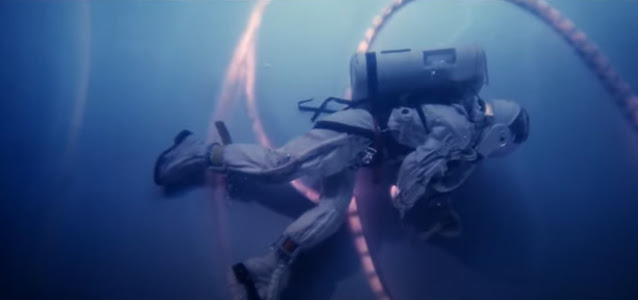Where Is 'The Abyss'? (Or What's at the Bottom of the World's Oldest, Deepest Lake?)
 |
| Scene from the 20th Century Fox movie The Abyss |
Hollywood and sci-fi have inspired astronauts, scientists and some of the most brilliant, inventive minds in modern history. On the flipside, they have also made the subject of UFOs or Unidentified Flying Objects a target of gaslighting and ridicule. While movies like James Cameron's "The Abyss" (and to another extent its 1989 cohort "The Little Mermaid") have expanded imaginations, their likes have also relegated the serious discussion and exploration of off-world vehicles to celluloid trifle.
The word UFO itself has become so loaded with mothership-sized stigma that the US government has opted to rebrand it into UAP or Unidentified Aerial Phenomena. The name change is part of the government's (begrudging?) efforts to heed the recent growing call for more communication and transparency on this centuries-old issue. It is likely coming to a head this summer with the impending arrival of a congressional report by the intelligence community on UAPs.
Early intel on the report indicates that the Pentagon will likely flake on elaborating about the possible celestial provenance of these exotic objects. At the same time, the US military will likely disavow ownership of the otherworldly tech, sources close to The New York Times say, while flirting with the idea that they could be arsenal from superpowered adversaries like Russia and Chinabecause military spending.
The black hole in that theory? Even the Russians are stumped by UFOs.
In 2009, Russia declassified its Cold War-era UFO sightings, including a strange incident in 1982 in Lake Baikal in southern Siberia. So what's at the bottom of Lake Baikal, only the world's deepest lake? Apparently, the 25-million-year-old body of freshwater was the site of one of the most compelling close encounters with what could have been undiscovered intelligent lifeforms.
The word UFO itself has become so loaded with mothership-sized stigma that the US government has opted to rebrand it into UAP or Unidentified Aerial Phenomena. The name change is part of the government's (begrudging?) efforts to heed the recent growing call for more communication and transparency on this centuries-old issue. It is likely coming to a head this summer with the impending arrival of a congressional report by the intelligence community on UAPs.
Early intel on the report indicates that the Pentagon will likely flake on elaborating about the possible celestial provenance of these exotic objects. At the same time, the US military will likely disavow ownership of the otherworldly tech, sources close to The New York Times say, while flirting with the idea that they could be arsenal from superpowered adversaries like Russia and China
The black hole in that theory? Even the Russians are stumped by UFOs.
In 2009, Russia declassified its Cold War-era UFO sightings, including a strange incident in 1982 in Lake Baikal in southern Siberia. So what's at the bottom of Lake Baikal, only the world's deepest lake? Apparently, the 25-million-year-old body of freshwater was the site of one of the most compelling close encounters with what could have been undiscovered intelligent lifeforms.
 |
| What lies beneath Lake Baikal in Siberia? Credit: Sergey Pesterev/Wikimedia Commons/CC BY-SA 4.0 |
We'll let the journalists at the Siberian Times narrate it for you:
At a depth of 50 metres, [seven military divers] met swimmers, around three metres tall, dressed in tight-fitting silvery suits. They did not have any scuba or other devices, just helmets on their heads. They received an order to catch the Ihtiander (half-boy, half-shark, from modern Russian folklore) - but they were immediately washed ashore with signs of decompression. They had two decompression devices, but one was broken. All seven people could not be put inside, so they put only four of them. And those three people, who were not put in the device, died on the beach.
 |
| What did Ed Harris see in 'The Abyss' (bottom) and what did the military divers see in the waters of Lake Baikal (top)? Photo above via amanderson2 |
Only five years before, something strange caught the attention of two scientists diving thousands of metres into the lake in a submersible device. What they saw next in the rayless waters perplexed them.
It was as if, the researchers said, their "device was lit from above and the side by two strong spotlights." The strange spotlights went out a minute later.
And that's just scratching the (lake's) surface. Apparently half of UFO encounters in Russia are connected with oceans, and 15 percent more are linked to lakes, Russian officials say.
Could extraterrestrial spacefarers actually be unknown seafarers on our lake and ocean floors? What is the nature of these USO (Unidentified Submersible Objects), which can both swim and take to the air at inhuman speeds? Well, the Russians are getting to the bottom of the mystery, literally. The Russian-led Joint Institute for Nuclear Research deployed in March a giant telescope, Baikal-GVD, not into orbit, but deep down into Lake Baikal. The telescope is designed to search for mysterious subatomic particles called neutrinos.
Is that a collective "Sure, Jan" we're hearing? Wherever you are on the alien belief spectrum, Cameron was really on to something with his flick.





Comments